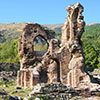Bacho Kiro cave

The Bacho Kiro cave is located about 5 km from the town of Dryanovo, near the Dryanovo Monastery, in the canyons of the Dryanovo River and the Andaka River. In 1940, it got its name in honour of the hero of the April Uprising Bacho Kiro. The skeleton of a bear with a height of 3 meters was discovered in it, as well as traces of bones of various animals. In 1962, it was declared a natural landmark and is among the 100 National Tourist Sites of Bulgaria.
There is a short and long route that you can take. During our visit the door to the long route was closed, so we took the short route. The tour of the short route with sightseeing and photography lasted about 30 minutes. It's wet and muddy inside, so it's a good idea to wear appropriate shoes and outerwear. The temperature inside is constant at 13°C and the humidity is 95%. The spectacular lighting throughout the cave makes its visit even more interesting.
The first hall through which one passes is called the Vestibule. From there, go through the Arch and reach the Rain Hall. By stone steps, you will reach the last one, called the Concert Hall, which has excellent acoustics. One of the attractions in the cave is Purgatory. According to belief, whoever manages to pass through the low, difficult passage is a righteous person.
The cave is interesting and beautiful, located in a beautiful area where there is much more to explore. The Dryanovsky Monastery is nearby, there are restaurants, and you can also visit several waterfalls along the way.
See also

Rock-hewn churches of Ivanovo
Rock-hewn churches of Ivanovo are included in the List of World Cultural and Natural Heritage under the protection of UNESCO. They are located within the nature park "Rusenski Lom", near the town of Ruse, Bulgaria, near the village of Ivanovo. There are many small rock churches, chapels and cells in the area, which form the monastery wreath which are named "St. Archangel Michael ”.
Explore
Slivodolsko Padalo waterfall
The Slivodolsko Padalo waterfall is highly picturesque, and with its height of about 50 meters is the highest waterfall in the Rhodopes, Bulgaria. It is located approximately 30 km from the city of Plovdiv and 15 km from the city of Asenovgrad, along the river Slivov dol and on the territory of the reserve "Red Wall".
Explore























































Comments
Leave comment